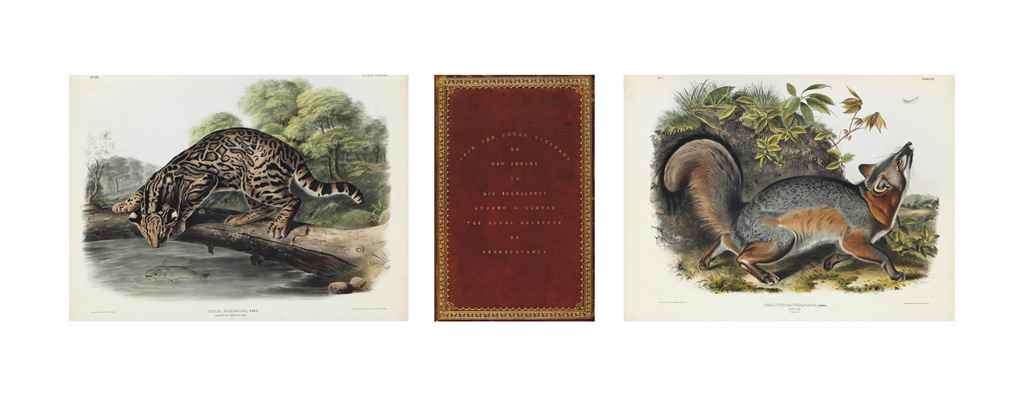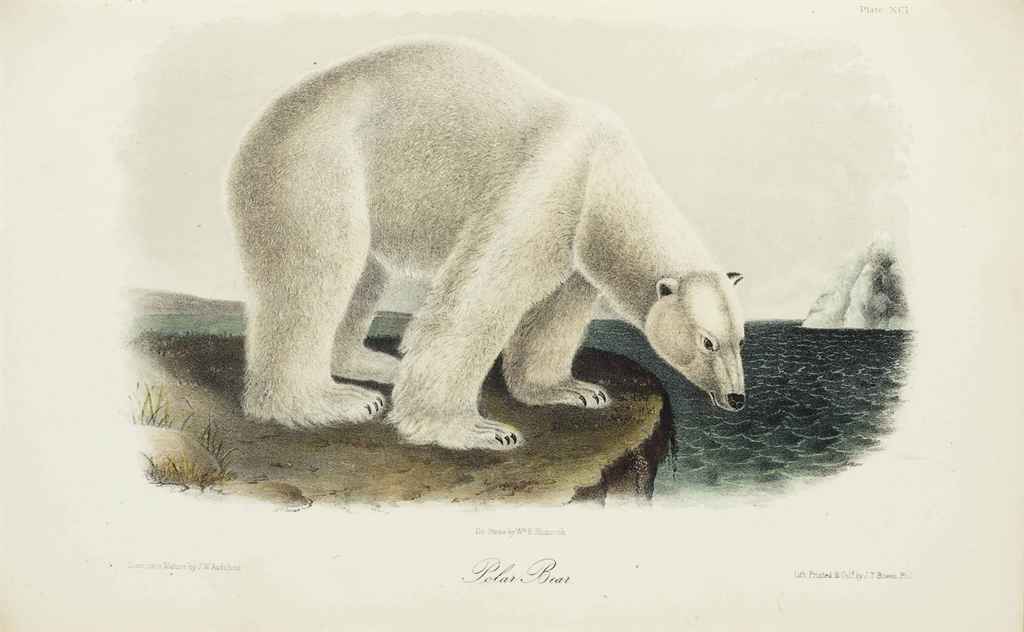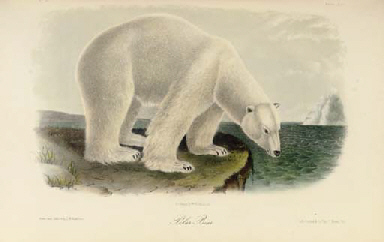AUDUBON, John James (1785-1851), and BACHMAN, Rev. John (1790-1874). The Viviparous Quadrupeds of North America . New York: J.J. Audubon, 1845-46-48. The first edition of Aububon’s folio Quadrupeds, the most ambitious of all color-plate books to be wholly produced in the United States . Audubon, the consummate woodsman and naturalist, made his first expedition across the Rockies to the Great Plains at the age of 58, in pursuit of mammals to draw for this edition. After an unsuccessful attempt to secure federal funding for his “Great Western Journey,” he determined that the commercial potential of the Quadrupeds was worth the risk to fund the expedition himself: “To render [the Quadrupeds ] more complete, I will leave the comforts of my home and beloved family, bound to the Rocky Mountains … I cannot tell how long I may be absent, but look to return loaded up with knowledge, new and abundant specimens on the shot and not from stuffed museums’ moth-eaten remains. I am told that I am too old to undertake such a long and arduous journey, but I reply that having the will, I will no doubt safely bear or even surmount the difficulties” (letter to C. Bonaparte, Feb. 1843, quoted in Rhodes). Audubon left St. Louis up the Missouri in April of 1843 along with a party of trappers and several Indians who had come to St. Louis for trade. Of the trappers, Audubon was astonished that their knowledge of animals was confined to useful furs only. However, Audubon enjoyed showing off his work to the Indians and one of his party, the naturalist Edward Harris, reported that one of the women actually ran away from Audubon’s specimen lithograph of the woodchucks, exclaiming that they were alive. After about 1000 miles, the party finally reached the prairie and a paradise of wildlife: elk, deer, bear, and wolves in plenty and buffalo by the thousands. Audubon was fascinated by the large animals. On his return home, he was soon in declining health and left many of the smaller mammals for his son, John Woodhouse to draw. A little over half the animals are after John James Audubon the remainder after his son, and the backgrounds are after his youngest, Victor Gifford, who also oversaw the printing and publication. It took the closely-knit Audubon family five years to publish the 150 plates, for which there were three hundred subscribers. The lithographer was J.T. Bowen to whom the Audubons were also entrusting the octavo edition of the Birds . The Quadrupeds was the most successful large color-plate book to be produced in America in the 19th century. The present copy has all three title-pages; sets are also found bound in two volumes, often without the title for vol. 3. The two-volume sets are a later issue and their coloring is less vivid than in the three-volume issue, as here. Audubon’s collaborator on the text was the pastor John Bachman, whose passion for American mammals equaled Audubon’s own for birds. Bachman was an exacting partner and they disputed points of accuracy and detail. No one, however, disputes the fruit of their labors: Audubon’s Quadrupeds is still one of the grandest and most beautiful depictions of American mammals ever produced. Bennett, p. 5; McGill/Wood, p.208; Nissen ZBI 162; Reese 36; Sabin 2367. See Rhodes, John James Audubon The Making of an American , 2004, pp. 417 ff. Three volumes, "elephant" broadsheet (711 x 559mm). 3 lithographic title-pages and 2 leaves of letterpress contents (first two titles repaired at one edge and reinforced on verso). 150 hand-colored lithographic plates after John James and John Woodhouse Audubon backgrounds after Victor Audubon, by J.T. Bowen (light soiling; occasional marginal repairs; light wear at corners, darkening to edges, and pin holes to several plates; approximately 44 plates on a paler paper stock, and one a slightly smaller size). Loose sheets in a later cloth portfolio. Provenance : Grand séminaire de Montréal (sold, Christie’s Canada, 28 September 1970, lot 2).
AUDUBON, John James (1785-1851), and BACHMAN, Rev. John (1790-1874). The Viviparous Quadrupeds of North America . New York: J.J. Audubon, 1845-46-48. The first edition of Aububon’s folio Quadrupeds, the most ambitious of all color-plate books to be wholly produced in the United States . Audubon, the consummate woodsman and naturalist, made his first expedition across the Rockies to the Great Plains at the age of 58, in pursuit of mammals to draw for this edition. After an unsuccessful attempt to secure federal funding for his “Great Western Journey,” he determined that the commercial potential of the Quadrupeds was worth the risk to fund the expedition himself: “To render [the Quadrupeds ] more complete, I will leave the comforts of my home and beloved family, bound to the Rocky Mountains … I cannot tell how long I may be absent, but look to return loaded up with knowledge, new and abundant specimens on the shot and not from stuffed museums’ moth-eaten remains. I am told that I am too old to undertake such a long and arduous journey, but I reply that having the will, I will no doubt safely bear or even surmount the difficulties” (letter to C. Bonaparte, Feb. 1843, quoted in Rhodes). Audubon left St. Louis up the Missouri in April of 1843 along with a party of trappers and several Indians who had come to St. Louis for trade. Of the trappers, Audubon was astonished that their knowledge of animals was confined to useful furs only. However, Audubon enjoyed showing off his work to the Indians and one of his party, the naturalist Edward Harris, reported that one of the women actually ran away from Audubon’s specimen lithograph of the woodchucks, exclaiming that they were alive. After about 1000 miles, the party finally reached the prairie and a paradise of wildlife: elk, deer, bear, and wolves in plenty and buffalo by the thousands. Audubon was fascinated by the large animals. On his return home, he was soon in declining health and left many of the smaller mammals for his son, John Woodhouse to draw. A little over half the animals are after John James Audubon the remainder after his son, and the backgrounds are after his youngest, Victor Gifford, who also oversaw the printing and publication. It took the closely-knit Audubon family five years to publish the 150 plates, for which there were three hundred subscribers. The lithographer was J.T. Bowen to whom the Audubons were also entrusting the octavo edition of the Birds . The Quadrupeds was the most successful large color-plate book to be produced in America in the 19th century. The present copy has all three title-pages; sets are also found bound in two volumes, often without the title for vol. 3. The two-volume sets are a later issue and their coloring is less vivid than in the three-volume issue, as here. Audubon’s collaborator on the text was the pastor John Bachman, whose passion for American mammals equaled Audubon’s own for birds. Bachman was an exacting partner and they disputed points of accuracy and detail. No one, however, disputes the fruit of their labors: Audubon’s Quadrupeds is still one of the grandest and most beautiful depictions of American mammals ever produced. Bennett, p. 5; McGill/Wood, p.208; Nissen ZBI 162; Reese 36; Sabin 2367. See Rhodes, John James Audubon The Making of an American , 2004, pp. 417 ff. Three volumes, "elephant" broadsheet (711 x 559mm). 3 lithographic title-pages and 2 leaves of letterpress contents (first two titles repaired at one edge and reinforced on verso). 150 hand-colored lithographic plates after John James and John Woodhouse Audubon backgrounds after Victor Audubon, by J.T. Bowen (light soiling; occasional marginal repairs; light wear at corners, darkening to edges, and pin holes to several plates; approximately 44 plates on a paler paper stock, and one a slightly smaller size). Loose sheets in a later cloth portfolio. Provenance : Grand séminaire de Montréal (sold, Christie’s Canada, 28 September 1970, lot 2).






.jpg)
.jpg)
.jpg)






Testen Sie LotSearch und seine Premium-Features 7 Tage - ohne Kosten!
Lassen Sie sich automatisch über neue Objekte in kommenden Auktionen benachrichtigen.
Suchauftrag anlegen